J0870
Permanent J-Code for RYTELOTM (imetelstat)
Effective January 1, 2025 for all sites of care.
It is the sole responsibility of the provider to select and enter proper codes in seeking coverage and reimbursement for an individual patient. Geron makes no guarantee regarding reimbursement.
INDICATION
RYTELO™ (imetelstat) is indicated for the treatment of adult patients with low- to intermediate-1 risk myelodysplastic syndromes (MDS) with transfusion-dependent anemia requiring 4 or more red blood cell units over 8 weeks who have not responded to or have lost response to or are ineligible for erythropoiesis-stimulating agents (ESA). See more
Give your ESA-ineligible or ESA-relapsed/refractory RS-negative and RS-positive patients with transfusion-dependent anemia
The possibility of zero transfusions

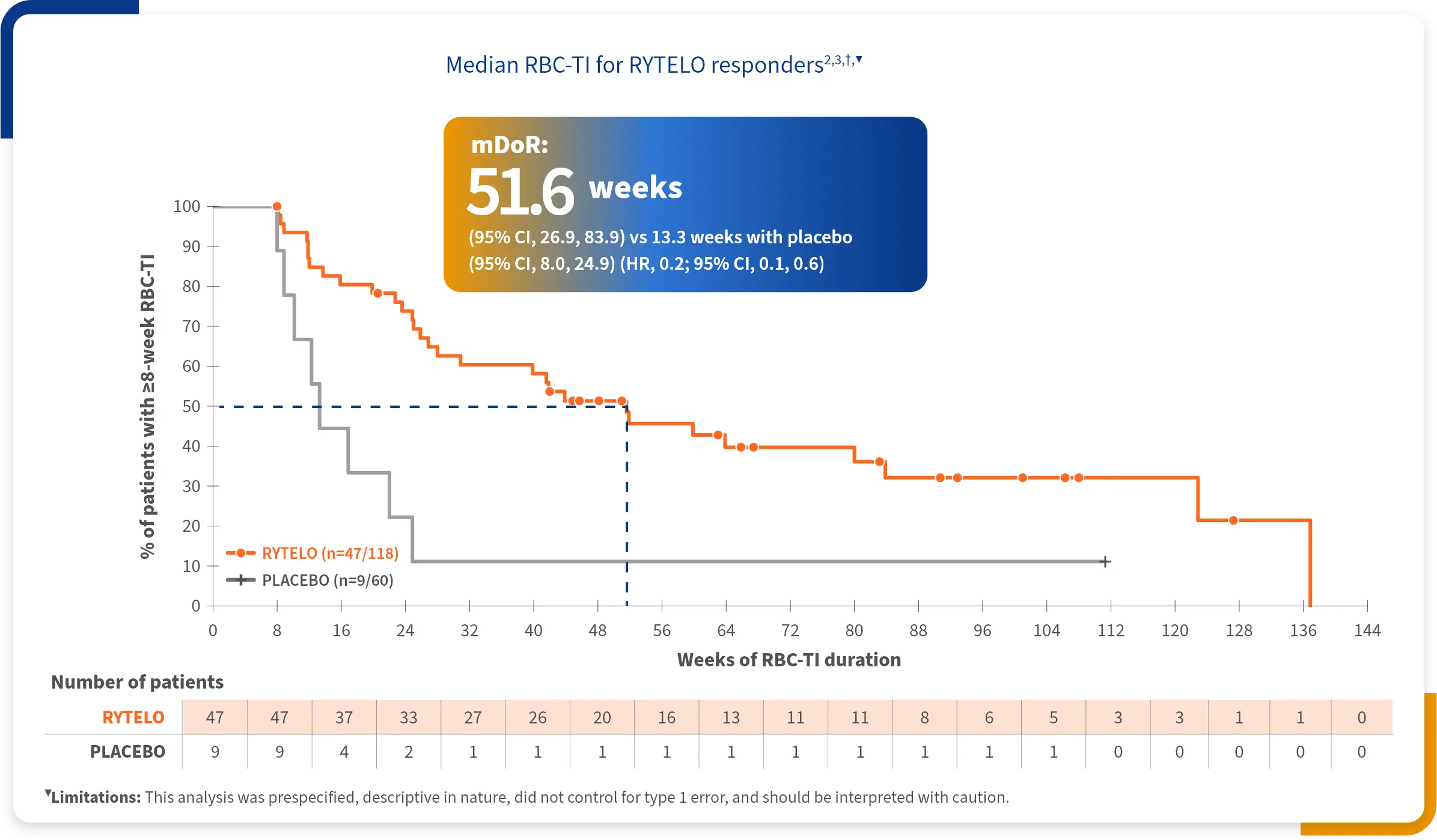
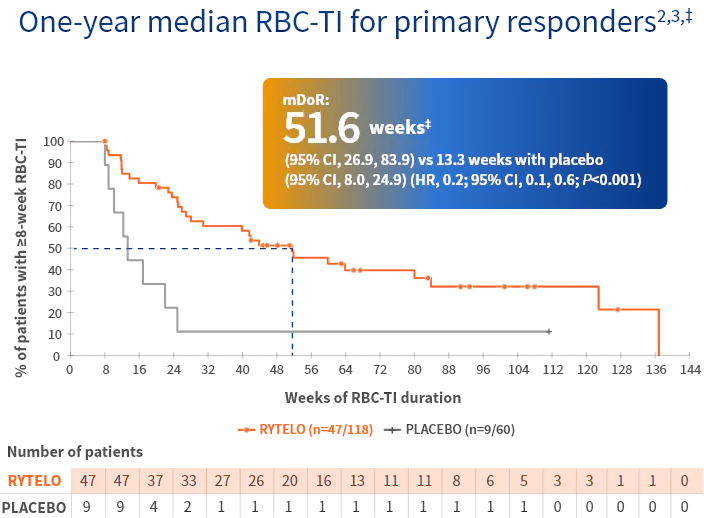
▼Limitations: This analysis was prespecified, descriptive in nature, did not control for type 1 error, and should be interpreted with caution.
Adapted from Platzbecker U and Santini V, et al. Lancet. 2024.
*Not all patients treated with RYTELO experienced 51.6 weeks of continuous RBC-TI.3
†Kaplan-Meier estimates of duration of RBC-TI; 8-week RBC-TI responder analysis set; HR is from the Cox proportional hazard model, stratified by prior RBC transfusion burden (≤6 vs >6 units RBC) and IPSS risk group (low vs intermediate-1), with treatment as the only covariate; P value for superiority of RYTELO vs placebo in HR using stratified log-rank test.3


Median duration of RBC-TI across RYTELO responders2,4
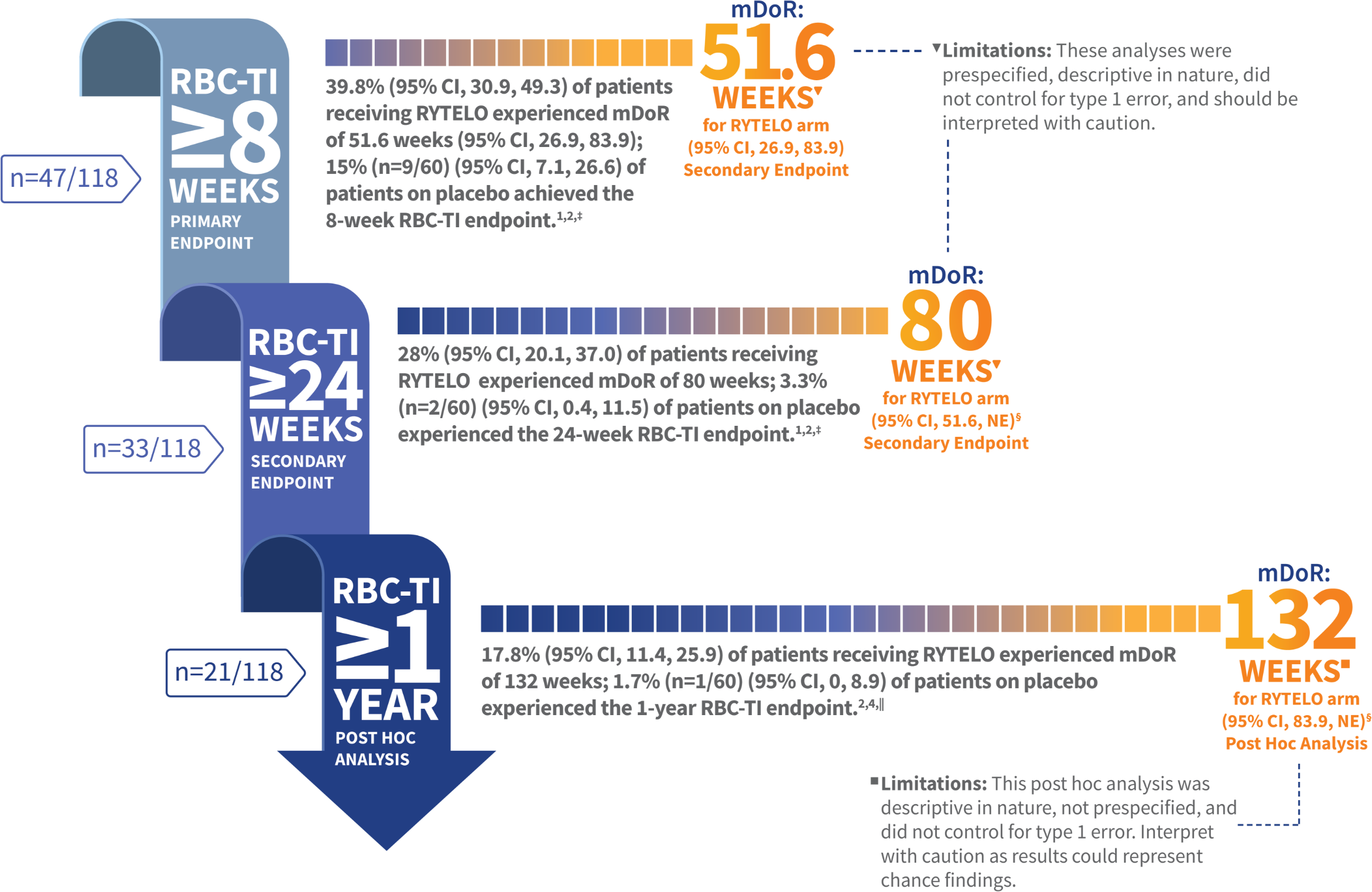
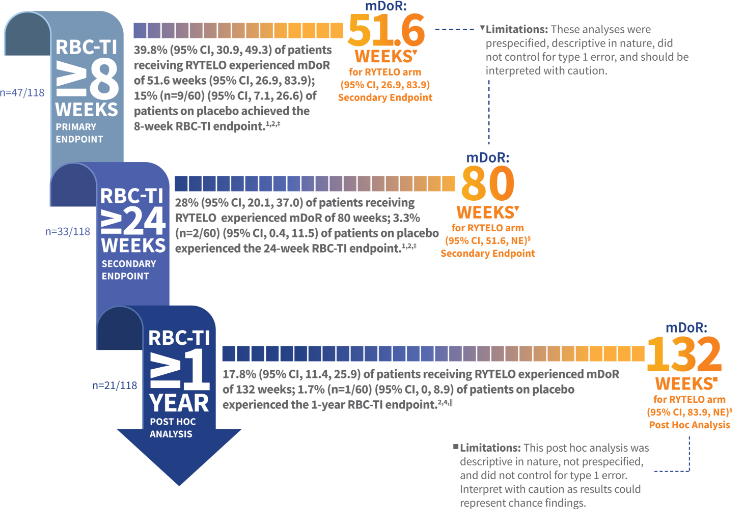
CI based on Clopper-Pearson exact confidence interval.
NE, not estimable.
‡≥8- and ≥24-week data cutoff: October 13, 2022.2
§mDoR for placebo NE due to low number of responders.2
‖ >1-year data cutoff: October 13, 2023.2
Median rise in Hgb levels for patients who maintained RBC-TI with RYTELO2,4
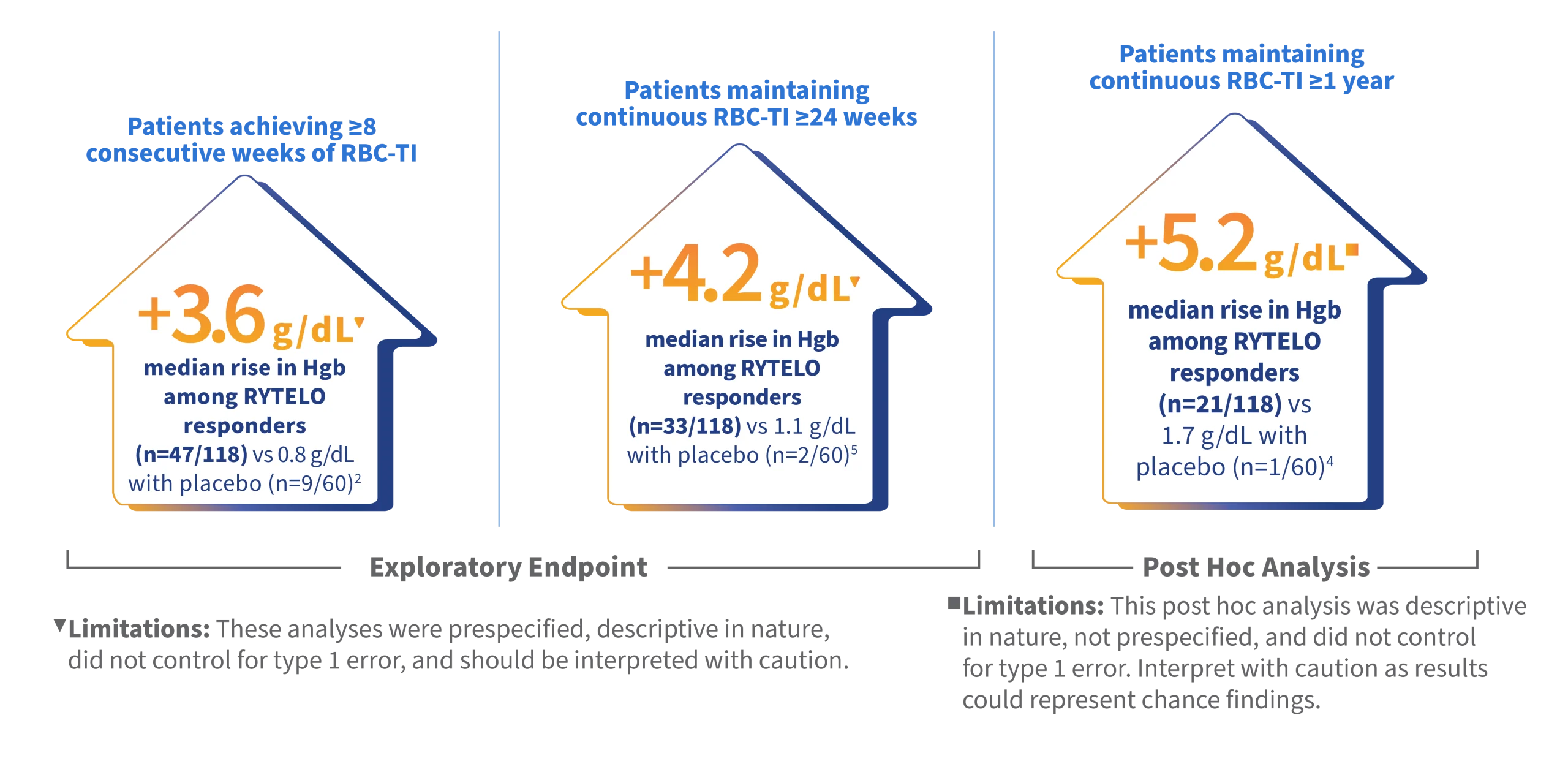
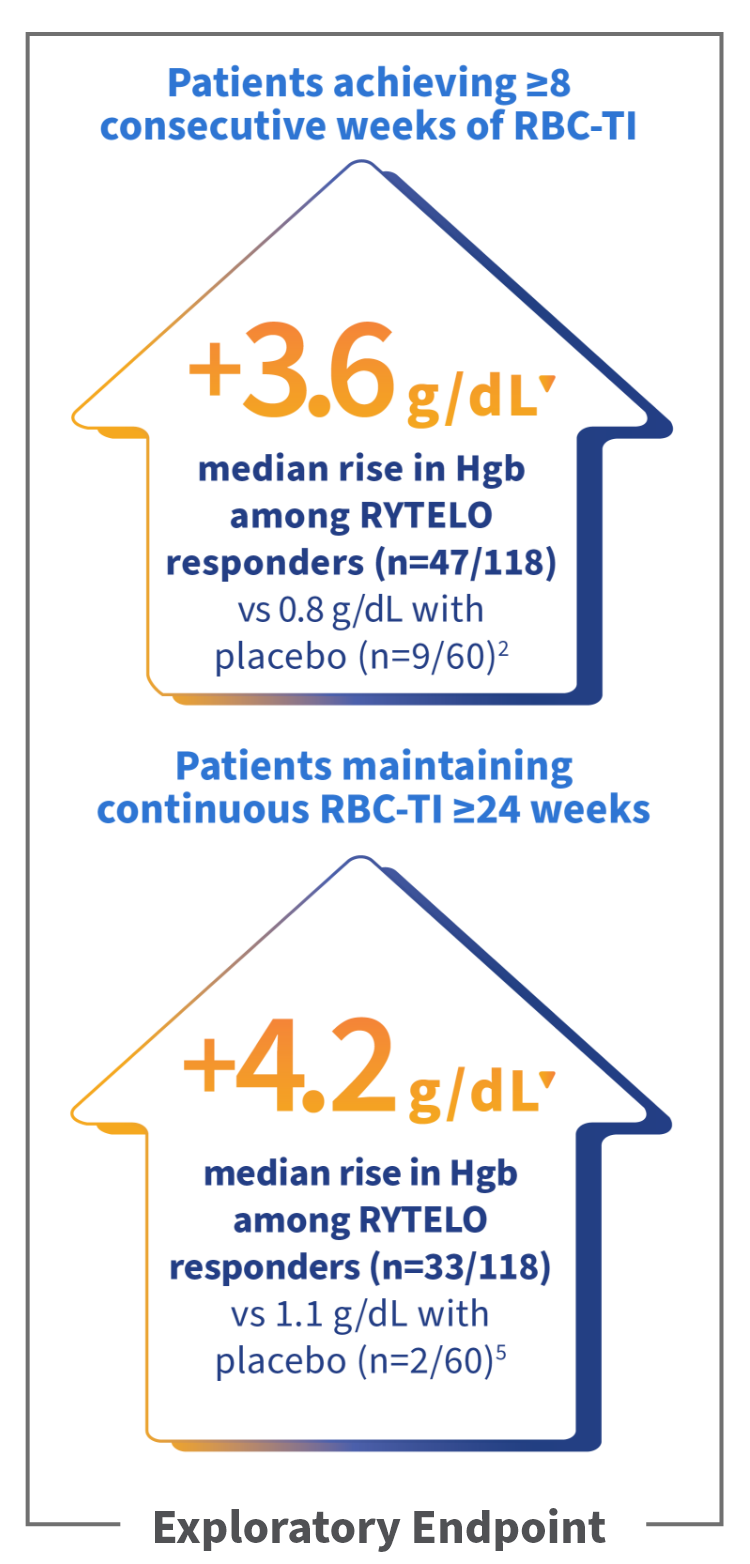
▼Limitations: These analyses were prespecified, descriptive in nature, did not control for type 1 error, and should be interpreted with caution.
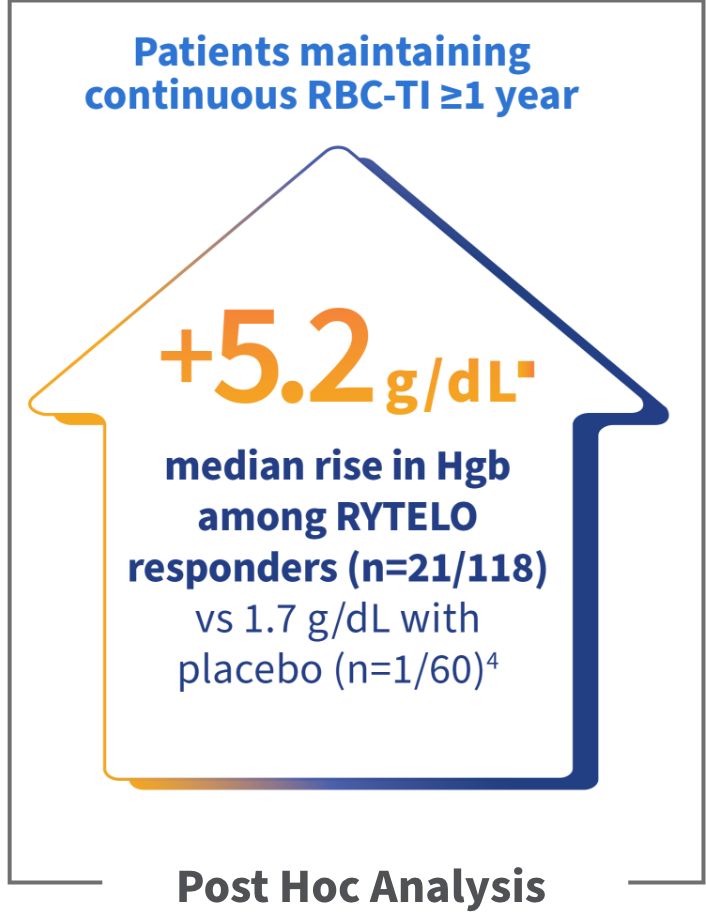
■Limitations: This post hoc analysis was descriptive in nature, not prespecified, and did not control for type 1 error. Interpret with caution as results could represent chance findings.
Mean change in Hgb levels for all patients in IMerge trial3,¶,▼
Adapted from Platzbecker U and Santini V, et al. Lancet. 2024.
▼Limitations: This analysis was prespecified, descriptive in nature, and did not control for type 1 error. Data points that have fewer than 4 patients are not shown. Interpret with caution as results could represent chance findings.
SE, standard error.
¶The mean changes from the minimum Hgb in the 8 weeks prior to the first dose date are shown. Hemoglobin measures from blood drawn within 14 days after a transfusion were excluded.3
Key LR-MDS subgroup analyses of ≥8-week RBC-TI6,▼
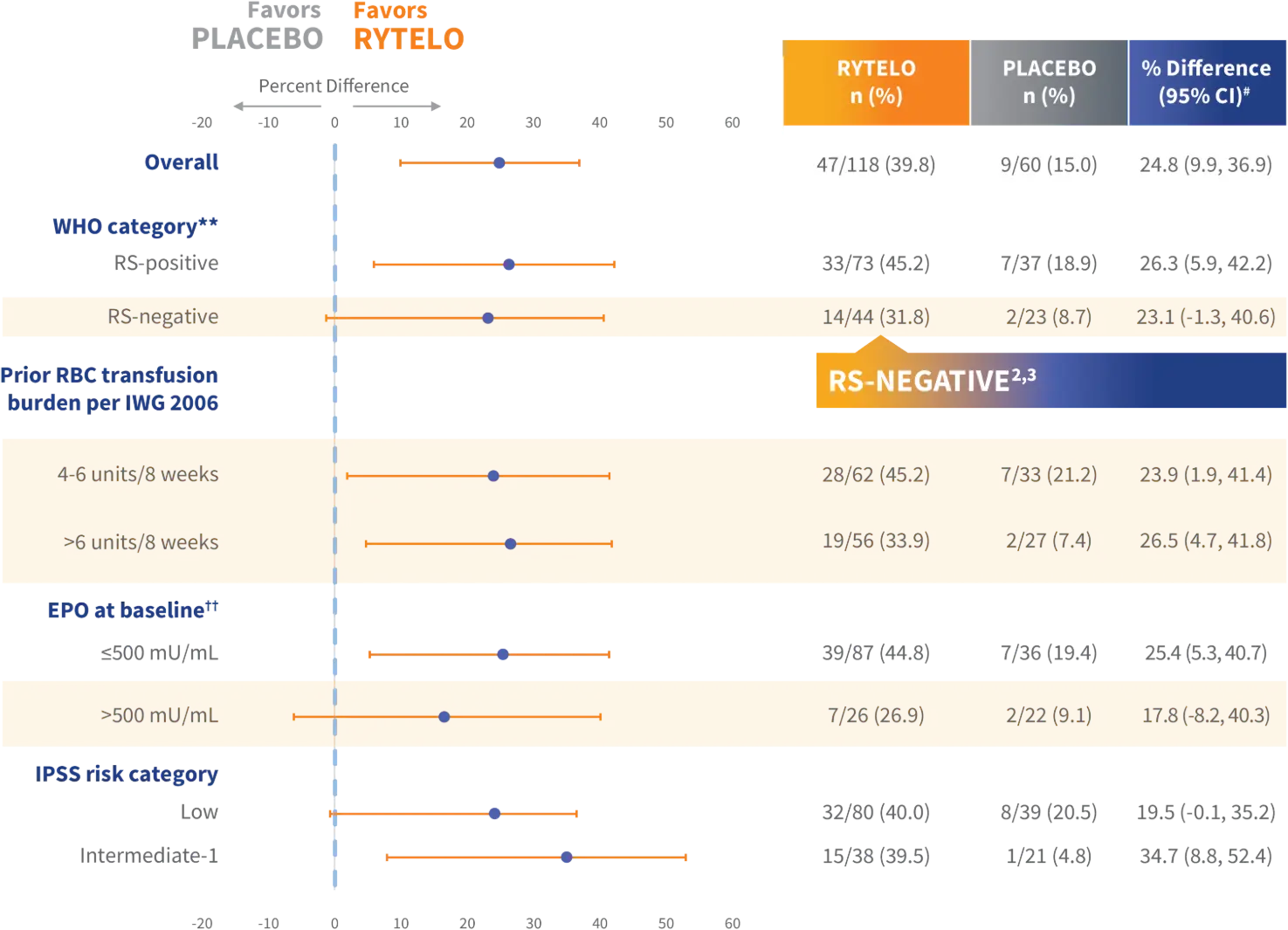
Adapted from Platzbecker U and Santini V, et al. Lancet. 2024.
▼Limitations: These subgroup analyses were prespecified, descriptive in nature, and did not control for type 1 error. Interpret with caution as results could represent chance findings.
#CI is provided for descriptive purposes only.
**One patient in RYTELO arm missing RS category.1
††Missing data for 5 patients in RYTELO arm and 2 patients in placebo arm for the EPO at baseline category.1
EPO, erythropoietin; ESA, erythropoiesis-stimulating agent; HR, hazard ratio; IPSS, International Prognostic Scoring System; LR-MDS, lower-risk myelodysplastic syndromes; mDoR, median duration of response; RBC-TI, red blood cell transfusion independence; RS, ring sideroblasts.
References: 1. RYTELO. Prescribing information. Geron Corp.; 2024. 2. Data on file. Geron Corporation. Foster City, CA. 3. Platzbecker U and Santini V, et al. Imetelstat in patients with lower-risk myelodysplastic syndromes who have relapsed or are refractory to erythropoiesis-stimulating agents (IMerge): a multinational, randomised, double-blind, placebo-controlled, phase 3 trial. Lancet. 2024;403(10423):249-260. 4. Platzbecker U, Komrokji RS, Zeidan AM, et al. Durable continuous transfusion independence with imetelstat in IMerge phase 3 for patients with heavily transfused non-del(5q) lower-risk myelodysplastic syndromes relapsed/refractory to or ineligible for erythropoiesis-stimulating agents. Blood. 2023;142(Supplement 1):4605. 5. Zeidan AM, Santini V, Platzbecker U, et al. Efficacy of imetelstat on red blood cell (RBC)-transfusion independence (TI) in the absence of platelet transfusions or myeloid growth factors in IMerge. J Clin Oncol. 2024;42(Supplement 16):6566. 6. Platzbecker U and Santini V, et al. Imetelstat in patients with lower-risk myelodysplastic syndromes who have relapsed or are refractory to erythropoiesis-stimulating agents (IMerge): a multinational, randomised, double-blind, placebo-controlled, phase 3 trial. Lancet. 2024;(Supplement)403(10423):published online Dec 1. https://doi.org10.1016/S0140-6736(23)01724-5


INDICATION
RYTELO™ (imetelstat) is indicated for the treatment of adult patients with low- to intermediate-1 risk myelodysplastic syndromes (MDS) with transfusion-dependent anemia requiring 4 or more red blood cell units over 8 weeks who have not responded to or have lost response to or are ineligible for erythropoiesis-stimulating agents (ESA).
IMPORTANT SAFETY INFORMATION
WARNINGS AND PRECAUTIONS
Thrombocytopenia
RYTELO™ (imetelstat) can cause thrombocytopenia based on laboratory values. In the clinical trial, new or worsening Grade 3 or 4 decreased platelets occurred in 65% of patients with MDS treated with RYTELO.
Monitor patients with thrombocytopenia for bleeding. Monitor complete blood cell counts prior to initiation of RYTELO, weekly for the first two cycles, prior to each cycle thereafter, and as clinically indicated. Administer platelet transfusions as appropriate. Delay the next cycle and resume at the same or reduced dose, or discontinue as recommended.
Neutropenia
RYTELO can cause neutropenia based on laboratory values. In the clinical trial, new or worsening Grade 3 or 4 decreased neutrophils occurred in 72% of patients with MDS treated with RYTELO.
Monitor patients with Grade 3 or 4 neutropenia for infections, including sepsis. Monitor complete blood cell counts prior to initiation of RYTELO, weekly for the first two cycles, prior to each cycle thereafter, and as clinically indicated. Administer growth factors and anti-infective therapies for treatment or prophylaxis as appropriate. Delay the next cycle and resume at the same or reduced dose, or discontinue as recommended.
Infusion-Related Reactions
RYTELO can cause infusion-related reactions. In the clinical trial, infusion-related reactions occurred in 8% of patients with MDS treated with RYTELO; Grade 3 or 4 infusion-related reactions occurred in 1.7%, including hypertensive crisis (0.8%). The most common infusion-related reaction was headache (4.2%). Infusion-related reactions usually occur during or shortly after the end of the infusion.
Premedicate patients at least 30 minutes prior to infusion with diphenhydramine and hydrocortisone as recommended and monitor patients for one hour following the infusion as recommended. Manage symptoms of infusion-related reactions with supportive care and infusion interruptions, decrease infusion rate, or permanently discontinue as recommended.
Embryo-Fetal Toxicity
RYTELO can cause embryo-fetal harm when administered to a pregnant woman. Advise pregnant women of the potential risk to a fetus. Advise females of reproductive potential to use effective contraception during treatment with RYTELO and for 1 week after the last dose.
ADVERSE REACTIONS
Serious adverse reactions occurred in 32% of patients who received RYTELO. Serious adverse reactions in >2% of patients included sepsis (4.2%), fracture (3.4%), cardiac failure (2.5%), and hemorrhage (2.5%). Fatal adverse reactions occurred in 0.8% of patients who received RYTELO, including sepsis (0.8%).
Most common adverse reactions (≥10% with a difference between arms of >5% compared to placebo), including laboratory abnormalities, were decreased platelets, decreased white blood cells, decreased neutrophils, increased AST, increased alkaline phosphatase, increased ALT, fatigue, prolonged partial thromboplastin time, arthralgia/myalgia, COVID-19 infections, and headache.
Please see full Prescribing Information, including Medication Guide.
You are encouraged to report adverse events related to Geron products by calling 1-855-437-6664 (1-855-GERON-MI) (US only). If you prefer, you may contact the US Food and Drug Administration (FDA) directly. Visit www.fda.gov/MedWatch or call 1-800-FDA-1088.
